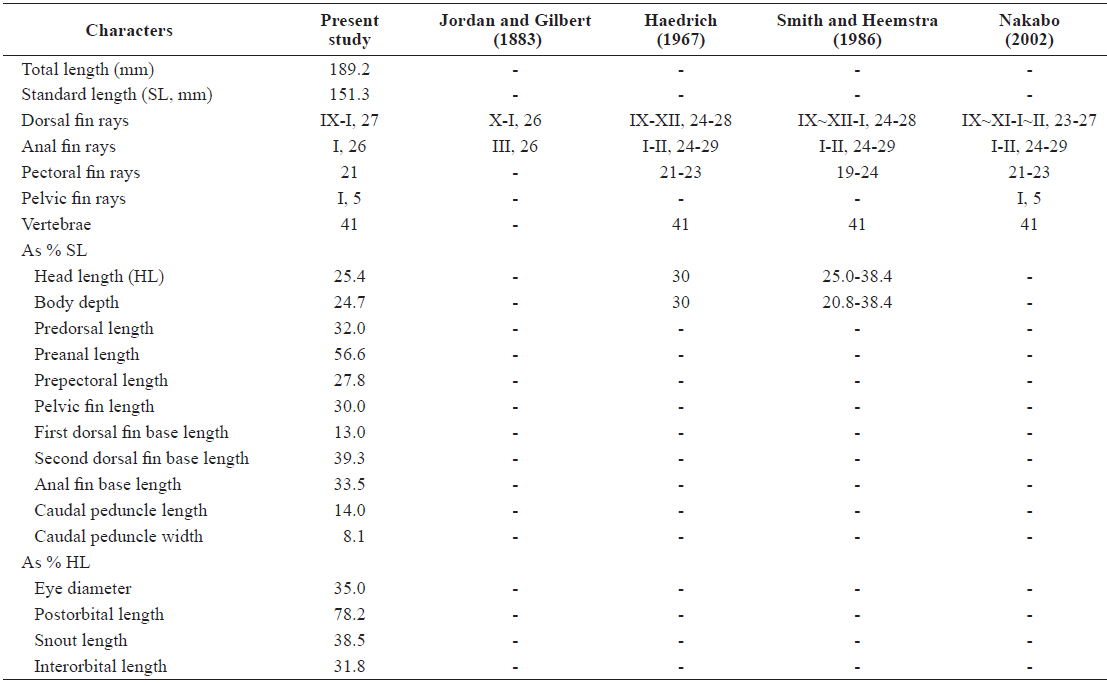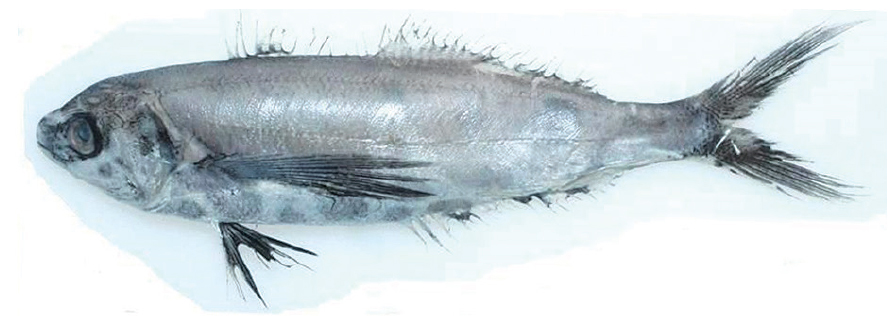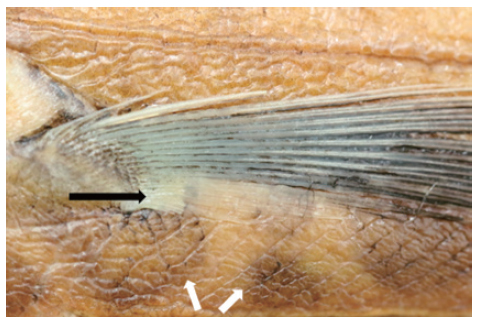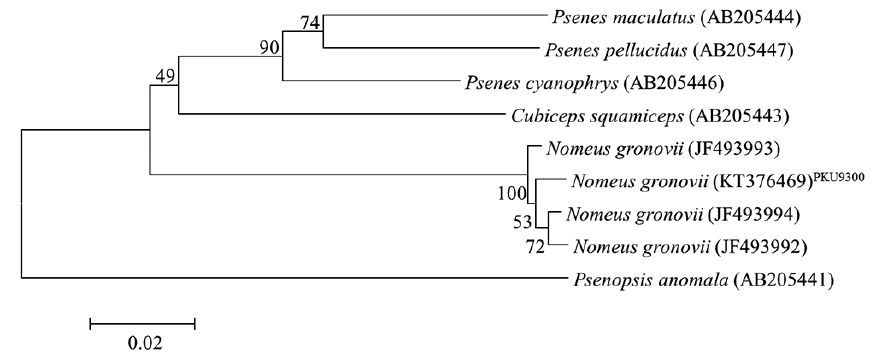The family Nomeidae (order Perciformes) consists of 16 species in three genera (Cubiceps, Nomeus, and Psenes) worldwide, and four species belonging to two genera occur in Korea (C. squamiceps, P. pellucidus, P. maculatus, and P. cyanophrys) (Nelson, 2006; Kim, 2011). The family is characterized by a compressed body, rounded snout tip, two dorsal fins, and an anal fin composed of I-III spines and 15-32 soft rays (Kim et al., 2005; Nelson, 2006). Among the family, only one species in the genus Nomeus has been identified (Nomeus gronovii, Gmelin, 1789) and this species is distinguished from other Nomeidae species by the presence or absence of scales above the head and the opercle, the shape and coloration of the pectoral fin, and the number of vertebrae.
During a survey of fish fauna, a single specimen belonging to the family Nomeidae was collected off Jeju Island, Korea, and identified as Nomeus gronovii. The description of the specimen and its identification as N. gronovii agree well with previous descriptions of the species (Jordan and Gilbert, 1883; Haedrich, 1967; Nakabo, 2002). This species has not been reported previously in Korea. Here, we describe the morphological characteristics and propose a new Korean name for this species.
On 8 July, 2013, a single specimen of N. gronovii was collected off Jeju Island, Korea. The specimen was preserved in 10% formalin and then in 70% ethanol. All counts and measurements were performed according to Nakabo (2002). The specimen was deposited at the Laboratory of Ichthyology, Pukyong National University (PKU).
Total DNA was extracted from the muscle tissue using the DNA extraction Kit (AccuPrep® , Bioneer, Korea) according to the manufacturer’s protocol. The mitochondrial cytochrome c oxidase subunit I gene (COI) was amplified from the DNA with a polymerase chain reaction (PCR) using the primer set of Ward et al. (2005). We also obtained the mitochondrial COI sequences of other Nomeidae species and of an outgroup from the National Center for Biological Information (NCBI) database. The sequences were aligned with BioEdit version 7 (Hall, 1999).The genetic distances (d) were calculated with the Kimura- two-parameter model (Kimura, 1980) and a neighbor-joining tree was constructed with 1000 bootstrap replications using the MEGA 5 software (Tamura et al., 2011). The nucleotide sequence data reported here have been submitted to the DDBJ/EMBL/GenBank nucleotide sequence databases under the following accession number: KT376469.
(New Korean genus name: Ga-neun-dong-gang-yeon-chi-sok)
Nomeus Cuvier, 1816:315 (type species: Gobius gronovii Gmelin, 1789, by subsequent designation of Jordan and Gilbert, 1883:449)
Body elongate and somewhat compressed, covered with small cycloid scales; bases of the second dorsal and anal fins very long; fan-like pelvic fin, large and broad; small teeth on jaws, vomer, and palatines; blotched and spotted pattern on the body; air-bladder present; numerous pyloric appendage; 41 vertebrae (Jordan and Gilbert, 1883; Haedrich, 1967).
(New Korean species name: Ga-neun-dong-gang-yeon-chi) (Figs.1-2, Table 1)
Gobius gronovii Gmelin, 1789: 1205 (type locality: western Atlantic; Brazil, southwestern Atlantic)
Nomeus gronovii: Haedrich, 1967: 83 (Atlantic Ocean); Nakabo, 2002: 965 (Japan); Ho et al., 2011: 253 (Taiwan).
PKU 9300, one specimen, 151.3 mm in standard length (SL), Jeju Island, Korea, 8 July, 2013, collected by Soo Jeong Lee, trawl.
Counts and measurements are given in Table 1. Body elongated and rather compressed; snout tip rounded; posterior end of the upper jaw reaches to below the anterior part of the eye; teeth on jaws, vomer, and palatines; dorsal fin scarcely separated and the origin of the first dorsal fin located a little behind the origin of the pectoral fin; bases of second dorsal and anal fins very long, second dorsal fin slightly longer than the anal fin, anal fin originating slightly behind the origin of the second dorsal fin, pectoral fin extending far beyond the origin of the anal fin, pelvic fin does not reach the origin of the anal fin, caudal fin deeply forked; pectoral fin mostly black, but lower part white. Groove present in the anterior part of the anus, connected to the pelvic fins; scales extend to the interorbital space on the dorsal surface of the head and are present above the gill cover, the area of the scales on the cheek does not reach the anterior margin of the eye; eye diameter moderate and slightly smaller than the snout length; nostrils located on the tip of the snout, anterior large and round and posterior slit.
When fresh, dorsal space is bright blue; ventral region silvery; there are dark blotches on the underside of the body; all fins are black except the lower part of pectoral fin; the margin of the eye is black; upper area and edge of the gill cover are black. After alcohol fixation, the head, body, and tail are mostly brown; large dark brown blotches on the underside of the body; dorsal, anal, and caudal fins brownish; pelvic and pectoral fins black, but lower pectoral fin white.
Known from western Atlantic including Newfoundland, Canada, and the northern Gulf of Mexico to Brazil (Robins and Ray, 1986), the eastern Atlantic, including north-west Africa and the Canary Islands (Hereau et al., 1986), and the western North Pacific, including Japan and Taiwan (Nakabo, 2002; Ho et al., 2011), and Korea (present study).
The family Nomeidae consists of three genera (Cubiceps, Psenes, and Nomeus) and the only species in the genus Nomeus has been known since the original description by Cuvier (1817). The genus Nomeus is distinguished from the other Nomeidae genera by the blotched and spotted pattern on the body and 41 vertebrae (Haedrich, 1967; Nakabo, 2002). In this study, a single specimen of Nomeidae collected off Jeju Island, Korea had a blotched and spotted pattern on its body, 41 vertebrae, a large pectoral fin with a white lower part, 27 soft rays in the dorsal fin, and 26 soft rays of anal fin. Therefore, the specimen was identified as N. gronovii. The molecular results support the morphological results. In a molecular analysis, a 500-bp sequence of the mitochondrial COI gene was amplified from the present specimen and compared with those of five species belonging to the family Nomeidae (Fig. 3). The present specimen showed the smallest genetic distance (d = 0.006-0.012) to N. gronovii collected in South Africa (NCBI accession number: JF493992- JF493994). The genetic distances to the other Nomeidae species were 0.143- 0.162. Four species of the family Nomeidae occur in Korea (P. pelluciuds, P. maculatus, P. cyanophrys, and C. squamiceps). Nomeus gronovii is readily distinguishable from P. pellucidus by the distribution of scales on its head (area of scales does not extend to the interorbital space in P. pellucidus vs area of scales extends to the interorbital space in N. gronovii). Psenes maculatus differs from N. gronovii in having scaleless areas above the gill cover, and the body shape of N. gronovii differs from that of P. cyanophrys (body ovoid in P. cyanophrys vs body elongate in N. gronovii). N. gronovii is readily distinguishable from C. squamiceps by its pectoral fin length (pectoral fin does not reach the origin of the anal fin in P. squamiceps vs pectoral fin extends far beyond the origin of the anal fin in N. gronovii) (Nakabo, 2002). The morphological description of the present specimen agree well with previous descriptions of the species, except for the number of anal fin spines by Jordan and Gilbert (1883), and the ratio of the head length to the body depth reported by Haedrich (1967) (Table 1). Haedrich (1967) suggested that morphological changes occur during the growth and development of the species. For example, the relative lengths of the pectoral and pelvic fins increase and decrease with growth, respectively. Therefore, further studies are required, based on more specimens, to identify the changes in morphological characters that occur with growth. In this study, we identified our specimen as Nomeus gronovii based on its morphological and molecular characters, and propose the new Korean name “Ga-neun-dong-gang-yeon-chi” for this species.








